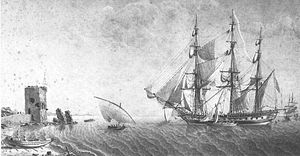French frigate Egyptienne (1799)

Portrait of Égyptienne by Jean-Jacques Baugean
|
|
| History | |
|---|---|
|
|
|
| Name: | Égyptienne |
| Builder: | Toulon |
| Laid down: | 26 September 1798 |
| Launched: | 17 July 1799 |
| Completed: | November 1799 |
| Captured: | 2 September 1801, by the Royal Navy |
|
|
|
| Name: | Egyptienne |
| Acquired: | 2 September 1801 |
| Fate: | Sold for breaking up 30 April 1817 |
| General characteristics | |
| Type: | 40-gun fifth-rate frigate |
| Tonnage: | 1,434 4⁄94 (bm) |
| Length: |
|
| Beam: | 43 ft 8 in (13.31 m) |
| Depth of hold: | 15 ft 1 in (4.60 m) |
| Sail plan: | Full-rigged ship |
| Complement: |
|
| Armament: |
|
Égyptienne was a French frigate launched at Toulon in 1799. Her first service was in Napoleon's Egyptian campaign of 1801, in which the British captured her at Alexandria. She famously carried the Rosetta Stone to Woolwich, and then the Admiralty commissioned her into the Royal Navy as the 40-gun fifth-rate frigate HMS Egyptienne. She served in a number of single-ship actions before being reduced to harbour service in 1807, and was sold for breaking in 1817.
Égyptienne was part of the two-ship Forte-class of frigates designed by François Caro. She had possibly been ordered on 15 June 1798 as a 74-gun ship-of-the-line of about 1,700 French tons, or 1900 English tons (the evidence is ambiguous). She was begun at Toulon on 26 September 1798 but while building she was modified into a heavy frigate based on the Forte. She was launched 17 July 1799, put into service in November 1799 and armed at Toulon on 23 September 1800. The foremost maindeck port was found too curved in the bow to admit a gun, so Égyptienne received only 48 cannon instead of 50.
In 1801 Napoleon required reinforcements in Egypt so the frigates Égyptienne and Justice, each carrying troops and munitions, left Toulon. On 3 February the vessels anchored in the old or western port of Alexandria.
The British discovered Causse, Égyptienne, Justice, Régénérée and two ex-Venetian frigates in the harbour of Alexandria at the capitulation on 2 September 1801 after the fall of Alexandria. The British and their Turkish allies agreed to a division of the spoils; the British received Egyptienne, Régénérée and Léoben (ex-Venetian Medusa) (26) while Captain Pacha (sic) received Causse (ex-Venetian Vulcano) (64), Justice (46), Mantoue (ex-Venetian Cerere) (26), and some Turkish corvettes that were in the harbour. Admiral Lord Keith commander of the naval forces, gave the value of Égyptienne for prize money purposes at £23,665 0s 0d.
...
Wikipedia
